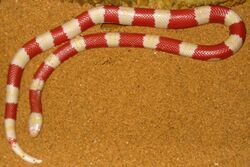Biology:Nelson's milksnake
| Nelson's milksnake | |
|---|---|

| |
| Albino Nelson's milksnake, Lampropeltis triangulum nelsoni | |
| Scientific classification | |
| Domain: | Eukaryota |
| Kingdom: | Animalia |
| Phylum: | Chordata |
| Class: | Reptilia |
| Order: | Squamata |
| Suborder: | Serpentes |
| Family: | Colubridae |
| Genus: | Lampropeltis |
| Species: | |
| Subspecies: | L. t. nelsoni
|
| Trinomial name | |
| Lampropeltis triangulum nelsoni Blanchard, 1920[1]
| |
Nelson's milksnake (Lampropeltis triangulum nelsoni) is a subspecies of king snake that is found in Mexico from southern Guanajuato[2] and central Jalisco[2] to the Pacific Coast.[1] It is also found on the narrow plains of northwestern Michoacán[2] and on the Tres Marias Islands.[1][2] The range of this snake appears to be tied to the proximity of watercourses, including ones utilized for irrigation and agriculture.[1] It is a subspecies of the milksnake, Lampropeltis triangulum. It is similar in size to other king snakes, averaging 42 inches (110 cm) long, and like them, it is nonvenomous.
This species is named in honor of Edward W. Nelson who worked for the U.S. Biological Survey from 1890, becoming chief in 1916.[3][4]
Characteristics
Size: Adults average 42 inches (110 cm) long.[1]
Habitat: Semi-arid coastal thorn scrub and interior tropical deciduous forests.[1]
Prey: Nelsons are opportunistic feeders. They will eat birds, small rodents, lizards, amphibians, and other snakes, including venomous species. It has a natural tolerance to the venoms of many native snakes.[5]
Appearance
The snake has 13 to 18 red rings and commonly has a dark-flecked light snout (in rare cases, the snout is mostly black).[1] While the red bands are quite wide, the black ones are noticeably thinner, and the white is very thin.[1] There is practically no black tipping on both the white and the red scales.[1] Albinism and pattern aberrancies are established.[1] It has 19 to 23 rows of smooth scales and a single anal plate.[5]
Until noted by Williams in 1978, it was not recognized that the L. t. sinaloae, or Sinaloan milksnake, found near Mazatlán, Sinaloa, Mexico, is a subspecies of milksnake distinct from the less common L. t. nelsoni.[6]
References
- ↑ 1.0 1.1 1.2 1.3 1.4 1.5 1.6 1.7 1.8 1.9 Bartlett, Richard D.; Markel, Ronald G. (2005). Kingsnakes and Milksnakes: Everything about Purchase, Housing, Health Care, and Breeding. Barron's Educational Series, Inc.. pp. 86. ISBN 978-0-7641-2853-0. https://books.google.com/books?id=PmU3hvbVeWsC.
- ↑ 2.0 2.1 2.2 2.3 "The Reptile Database, Lampropeltis triangulum LaCépède, 1789". http://reptile-database.reptarium.cz/species.php?genus=Lampropeltis&species=triangulum. Retrieved 2007-06-24.
- ↑ Bell, Edwin L.; Smith, Hobart M.; Chiszar, David (2003). "An Annotated List of the Species-Group Names Applied to the Lizard Genus Sceloporus.". Acta Zoológica Mexicana (90): 103–174. https://www.redalyc.org/pdf/575/57509006.pdf.
- ↑ Beolens, Bo; Watkins, Michael; Grayson, Michael (2011). The Eponym Dictionary of Reptiles. Baltimore: Johns Hopkins University Press. xiii + 296 pp. ISBN:978-1-4214-0135-5. (Lampropeltis triangulum nelsoni, p. 188).
- ↑ 5.0 5.1 "The Nelson's Milksnake, Lampropeltis triangulum nelsoni.". Archived from the original on 2006-11-07. https://web.archive.org/web/20061107132744/http://www.herpscope.com/cgi/herpguide.cgi?Action=lookup&Key=Lampropeltis+triangulum+nelsoni. Retrieved 2007-06-24.
- ↑ "Nelson's Milk Snake". Applegate Reptiles. http://www.applegatereptiles.com/species/nelsoni.htm. Retrieved 2007-06-24.
Wikidata ☰ Q2382700 entry
 |



